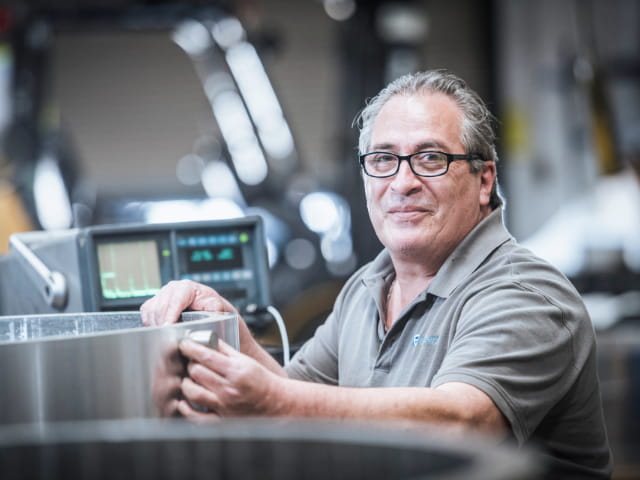The Clear Advantages of Ultrasonic Testing
How Does UT Work?
The UT process is remarkably simple and safe. A handheld probe is coupled to the surface of the test object using a thin gel couplant. The probe generates high-frequency sound waves that travel into and through the material. If the sound waves strike an interior flaw or defect, they reflect back and are picked up by the same probe's receiver. The reflected ultrasonic waves are converted into an electrical signal, providing a clear representation of the internal characteristics and condition of the object under inspection.
UT is commonly used to inspect metal components, composites, plastics and more across industries like aerospace, automotive, power generation, and oil & gas. Since no radiation is involved, UT avoids safety risks and is ideal for use in the field or manufacturing facilities.
The Power of Phased Array
For even more detailed flaw detection and sizing, phased array ultrasonics takes UT capabilities to the next level. Phased array probes contain multiple tiny ultrasonic transducers arranged in a compact line. By pulsing these transducers at specific times, the combined wavefront can be focused, deflected, and swept electronically to generate ultra-precise 3D mapping data of an object's internal geometry.
This advanced phased array technology excels at thoroughly inspecting complex geometry parts, detecting and sizing the smallest defects, and evaluating difficult-to-reach areas. Paired with portable phased array UT instruments, it provides outstanding field inspection results.
Taking the Right Approach to Ultrasonic Testing
Ensuring your critical components meet the highest standards requires partnering with an ultrasonic testing (UT) provider that combines advanced capabilities with deep expertise. Here are some key factors to prioritize:
- Authoritative Certifications: Look for a UT inspection company with technicians certified to stringent industry standards like ASNT SNT-TC-1A, NAS 410, and ISO 9712. Having personnel qualified by respected organizations like ACCP (ASNT Central Certification Program) is a mark of true expertise.
- State-of-the-Art Methods: For maximum accuracy and detail, seek out providers utilizing the latest phased array ultrasonic testing technology. Phased array UT allows precise 3D mapping, detecting and sizing even the smallest flaws in complex geometries that conventional UT may miss.
- Flexible Field Services: When it's not feasible to bring components to a lab, having access to UT field services can be invaluable. An experienced team capable of conducting comprehensive UT inspections at your location minimizes downtime.
- Proven Track Record: Whether for automotive, aerospace, power generation or other sectors, choose an ultrasonic testing company with extensive experience successfully inspecting the types of materials and components critical to your operations. A strong industry reputation demonstrates their commitment to quality.
- Comprehensive Solutions: For added value, consider providers offering complementary NDT methods like radiography testing. This enables more complete evaluations tailored to your specific testing requirements.
By prioritizing these factors, you can confidently obtain the clear, reliable ultrasonic data needed to assure quality, identify issues, and ultimately prevent failures before they occur.
“A major advantage of UT is that it does not involve any radiation safety concerns, making it safer for field inspections.”
Ultrasonic Testing vs Radiography Testing
While both ultrasonic testing (UT) and radiography testing (RT) are powerful nondestructive evaluation methods, there are some key differences. RT uses penetrating radiation like x-rays or gamma rays to create images of a component's internal structure. This allows detection of things like cracks, corrosion, and inclusions. UT, on the other hand, employs high-frequency sound waves to locate and characterize flaws based on reflected ultrasonic signals.
A major advantage of UT is that it does not involve any radiation safety concerns, making it safer for field inspections. Ultrasonic testing also excels at inspecting materials that are difficult to radiograph, like ceramics, plastics, and austenitic stainless steels. However, radiography provides actual image files that can be permanently recorded, whereas UT data must be interpreted from signals.
The most powerful approach combines the strengths of both methods through advanced techniques like phased array ultrasonics and computed tomography (CT) radiography. This hybrid solution offers highly accurate sizing and visualization of flaws within complex components unmatched by conventional methods alone.
Explore a partnership with Element for UT/RT
With flexible UT/RT field services, state-of-the-art labs, and unmatched expertise across industries like aerospace and power generation, Element delivers powerful multi-modal inspections tailored to your needs. Precisely locate internal flaws while keeping assets undamaged to enable quality assurance, timely repairs, and prevent failures. Trust Element's comprehensive UT/RT solutions to maximize integrity for your most critical components.
Find related Resources

